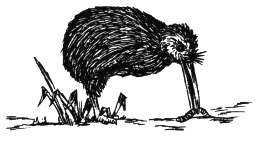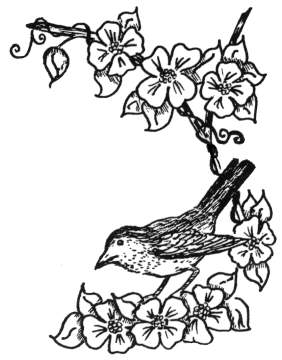 (Pronounced "kee-wee." Sometimes called "apteryx."
(Pronounced "kee-wee." Sometimes called "apteryx."
About Birds |
Mina Arnold Young
Illustrated by |
|
|
 (Pronounced "kee-wee." Sometimes called "apteryx."
(Pronounced "kee-wee." Sometimes called "apteryx."
If we had an election for the strangest looking bird in all the world, the kiwi would be a good candidate. It has stringy feathers, no tail, and just little knobs where its wings should be.
Kiwis -- what are left of them -- live only in New Zealand. As more of the land is taken over by people, there is less for the little wild things. So some of them are in danger of becoming extinct. Kiwis would probably be extinct already if there were not laws against killing them. Some people like to eat them! But the leaders of New Zealand are proud of their kiwis and use their pictures on money and stamps.
It's hard to learn much about the kiwi because it hides away and sleeps in the daytime and only comes out at night to feed. The kiwi is not only different from other birds in that it has no tail and very little wing, but it has something other birds do not have. It has a good sense of smell. (Many other birds are better off without that, especially those that nest in large colonies.) The kiwi's nostrils are near the tip of its bill, rather than up near its head. Around the base of the bill are long thread-like feathers something like a cat's whiskers. These probably help it find its way around in the dark, as it goes sniffing about hunting for earthworms.
 The kiwi is only about as large as a chicken, but the female lays an egg 5 inches long, weighing about a pound. So it seems only fair that the male does the incubating. That's a big job too. It takes 75 or 80 days for the egg to hatch. Then the baby kiwi stays in the nest for 6 days without food. No wonder the egg had to be so large! It had to provide food for the little bird for about 12 weeks.
The kiwi is only about as large as a chicken, but the female lays an egg 5 inches long, weighing about a pound. So it seems only fair that the male does the incubating. That's a big job too. It takes 75 or 80 days for the egg to hatch. Then the baby kiwi stays in the nest for 6 days without food. No wonder the egg had to be so large! It had to provide food for the little bird for about 12 weeks.
Sometimes the female lays another egg three or four weeks after the first, so the male may be on the nest for almost four months. Since the baby kiwis get out and forage with their parents after the first six days in the nest, no doubt Mom Kiwi takes care of the first baby that hatched while good old Dad finishes incubating the second egg.
At one place in New Zealand, in what could be called a "kiwi sanctuary," nesting boxes are provided for the birds. Caretakers noticed that when the male was on the nest the female would come to the box every now and then and tap on it with her bill. The male inside would tap back. We are not told whether she brings his meals to him while he is incubating the eggs, or whether he has to take little lunch breaks during the night.
There's no way that a bird could give itself a sense of smell, or change nostrils from high up on the beak to down near the tip.
Since kiwis have just what they need for the kind of life they live, they had to be designed by God.